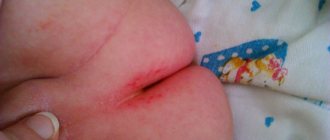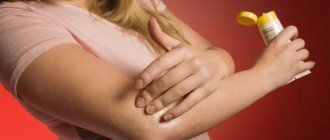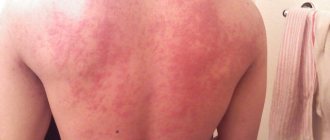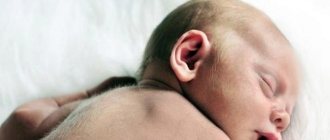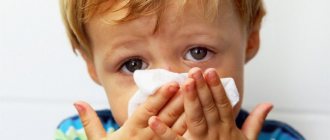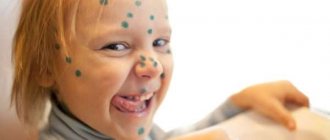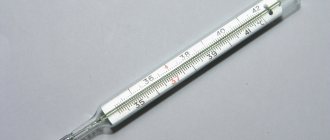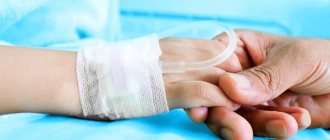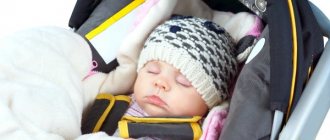Causes
The causes can be divided into two large groups - infectious and non-infectious.
Non-infectious
Prickly heat
The most harmless reason is sweat rash. Sweat, which is produced in large quantities during a fever, leads to local irritation of the delicate baby skin.
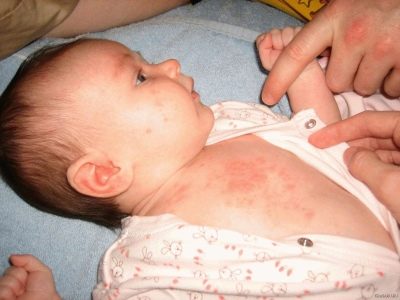
The ducts of the sweat glands in children have an anatomical age-related feature - they are narrow, the discharge of sweat is difficult, and the sweat glands can become inflamed because of this. This is how the rash appears.
Such rashes can be distinguished from others by strong redness around the elements of the rash ; the erythema can be quite extensive and cover the entire area of skin folds. Places where the rash is localized are skin folds, groin area, buttocks, armpits, folds under the chin, scalp skin, and scalp.
This phenomenon should not cause much concern. Under the influence of fresh air and clean water, the rash quickly disappears. The child should be rinsed with warm, but not hot water, the diaper rash should be treated with Bepanten or spray (if the rash is wet), and the baby should be changed into clean and dry clothes made from natural fabrics.
Don't dress him too warmly. At temperatures above 38.0 degrees, it is better to completely undress the child down to his underpants.
Allergy
When the baby gets sick, parents begin to give antipyretics. It is to them that an allergic reaction can develop. The likelihood of an allergic rash increases if fever medication is given in the form of a sweet syrup. If parents start using other medications, the risk of an allergic reaction increases several times.
An allergic rash can appear as red spots with bumps, peeling and crusts, most often on the cheeks, chest and neck. An allergic rash is usually noticeable because it is itchy and itchy. Individual elements can merge, creating large lesions.
If such a rash appears in a child under one year old, you should definitely call a pediatrician.
He will prescribe an antihistamine according to age, and will also be able to recommend an ointment with an antihistamine effect. If the allergy is extensive, then the doctor may prescribe an ointment based on glucocorticosteroid hormones.
Infectious
If during a fever or after a high temperature a rash appears on the body, face, or limbs, this may be a sign of an infectious disease.
Chickenpox
The rash associated with this infectious disease has a characteristic appearance and style of “behavior.” It appears against a background of a temperature of 37.5-38.0 degrees; bubbles with serous fluid form from the tubercles in a matter of hours.
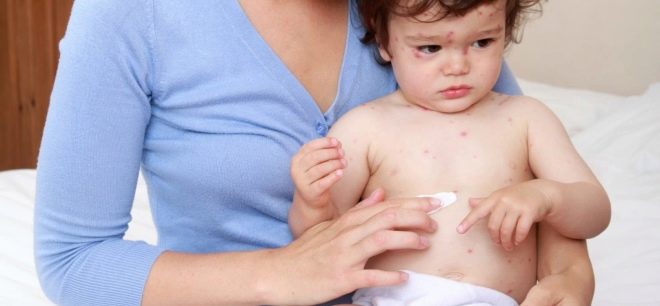
When these vesicles burst, a yellowish crust appears in their place, which is quite itchy, and new elements appear nearby.
The rash can be observed all over the body . In addition to it, chickenpox is characterized by symptoms typical of a viral infection: headache, respiratory symptoms in the form of a runny nose and cough, a feeling of aching muscles and joints. Some children may experience abdominal pain and even diarrhea.
Whether to treat chickenpox or not is a rhetorical question, since there are no drugs that could somehow affect the speed of recovery. But there are medications that help reduce the symptoms of the disease.
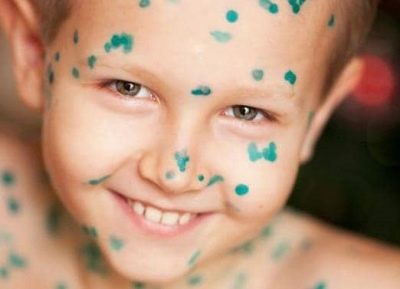
To begin with, parents should definitely call a doctor at home , since chickenpox, like most other infections with skin rashes, is very contagious.
For a mild form of the disease, the doctor will recommend bed rest, plenty of fluids and a light diet. To reduce the temperature of chickenpox , Paracetamol is given; after opening the vesicles, the rash is treated with brilliant green or Acyclovir.
Measles
This is also a very contagious viral infectious disease, in which a small child first develops a fever and then a rash. The temperature can reach 39.0 degrees and above, and lacrimation appears.
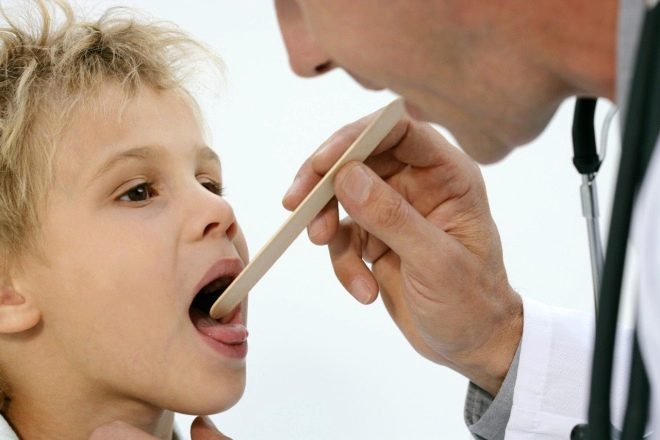
The rash looks quite characteristic - it is a small red rash that appears 3-4 days after the onset of an acute illness. First, the rash appears on the mucous membranes - in the mouth, on the inner surface of the cheeks, on the palate, after which it quickly spreads throughout the body. Mild itching may occur.
Most often, measles affects children between 1 and 5 years of age. Babies under one year of age rarely become infected with this disease; they are protected by antibodies received from the mother, the so-called innate immunity.
Treatment of measles is not much different from treatment of other viral infections. The child is prescribed bed rest, plenty of warm drinks, and a diet.
Antiviral drugs, although prescribed everywhere by local pediatricians, do not have any effect on the course of the disease. Therefore, therapy is symptomatic: for high fever - antipyretics, for itchy skin - antihistamines. The rash does not require special treatment.
Rubella
With this disease, the temperature also first rises (up to 38.0 degrees), a sore throat appears, the lymph nodes become enlarged, and only on the 3rd day the first rashes on the skin may appear.
The rash itself is small, oval, pink . Its individual elements do not merge with each other. The first rashes appear on the face and neck, but within a couple of hours the rash already covers the entire body.
After three days, the rashes begin to fade and gradually disappear. The temperature can remain the same all this time.
If you have rubella, the child should be isolated from other children and especially from pregnant women. The rest of the care for the baby is quite standard - vitamins, bed rest, drinking and ventilation of the room. The rash does not need treatment.
Roseola infantile or sudden exanthema
If after three days of high (up to 39.0 and above degrees) temperature the child feels better, the fever subsides, and 10-12 hours after that the body, head, face are covered with a pinkish rash, then we are most likely talking about roseola, a three-day fever or the so-called “sixth disease”.
Causes of rash and fever
Prickly heat
Such rashes can perhaps be called the most common and safest for a baby. As a rule, heat rash appears only in infants and small children, who themselves do not yet understand that they are hot and cannot take off excess clothing.
Often caring grandmothers and young mothers try to wrap up the baby more tightly and dress him warmer, as a result of which the body overheats and the temperature rises. The child begins to sweat a lot, which is often perceived as chills and a sign of a cold.
Plenty of clothing and warm blankets prevent sweat from evaporating from the surface of the body. After some time, the overheating goes away, and a small watery rash appears on closed areas of the body.
Miliaria causes a lot of anxiety for the baby, as it is accompanied by severe itching. Some parents, seeing such rashes, begin to give their child antihistamines, but in this case they are useless, since the body’s reaction is not allergic.
Treatment of prickly heat involves bathing the baby (the skin should be clean) using mild detergents, as well as decoctions of string, chamomile or oak bark, followed by taking air baths. If your baby is bothered by itching, you can lubricate the affected areas with baby cream.
READ ALSO: Red rash on the body of an adult itches
To prevent the appearance of prickly heat, it is necessary to monitor the state of the atmosphere in the room and prevent the child from overheating. Read more about heat rash in babies →
Allergic reaction
It is important to remember that fever is a common accompaniment of food allergies or reactions to insect bites. Allergic rashes can also appear after taking any medications, for example, antipyretics or antivirals.
Before giving your baby antihistamines, it is necessary to accurately determine that the rash on the body is caused by an allergy and not by an infectious disease, and for this you should consult a doctor. In the future, after identifying specific allergens, it is necessary to protect the baby from contact with them. Read more about allergy symptoms in children →
In addition to the usual prickly heat and an allergic reaction, a rash after a fever may also appear as a consequence of the onset of any infectious disease.
Chickenpox
The rash is usually preceded by a slight malaise with symptoms of acute respiratory infections. The onset of the rash is characterized by the appearance of several elements in different parts of the child’s body, the number of which quickly increases. Gradually, bubbles appear from these spots, which subsequently dry out, forming crusts.
Under no circumstances should such blisters be damaged, otherwise scars will remain in their place. On average, the disease lasts about two weeks, and the baby is contagious during this time. Chickenpox rashes are characterized by widespread distribution, not excluding the mucous membranes and scalp. Read more about chickenpox →
Chickenpox in children does not require any special treatment. A sick child, with the normal course of the disease, is at home, isolated from other children, taking only antihistamines to eliminate itching.
Rubella
The disease begins with mild symptoms of acute respiratory infections, after which an abundant small rash in the form of pale pink spots appears throughout the body. Rubella has a pronounced distinctive feature that allows you to accurately isolate the disease. This is an enlargement of the lymph nodes in the back of the head.
READ ALSO: Is it possible to bathe a child with an allergic rash: methods and restrictions
The disease occurs unexpectedly and also suddenly disappears after 3-4 days, without requiring any special treatment. As a preventive measure against rubella, routine vaccination is recommended for all babies under one year of age. Read more about the signs of rubella in children →
The onset of the disease is characterized by the acute manifestation of all symptoms of acute respiratory infections, such as runny nose, severe cough, high temperature, conjunctivitis. A rash in a sick child begins to appear on the 4th day, first on the face and in the upper chest area. The rash then spreads (on the second day) to the entire body area.
On the third day, elements are found on the arms and legs. Small red spots spread over 3 - 4 days, can merge with each other, after which they disappear. Today, measles occurs only in isolated cases, since all babies under one year of age undergo routine vaccination against this disease.
Scarlet fever
The disease is characterized by a sudden and acute onset, accompanied by a sore throat, sore throat and high fever. At the very beginning, the baby's tongue is covered with a thick white coating, which later turns red.
Rashes in a sick child appear quickly, literally a few hours after the onset of the disease, and rapidly spread, condensing in the armpits, on the elbows and knees, in the groin area and other natural skin folds. The rash is pinpoint in nature and covers the entire body, except for the area around the mouth - it remains very pale.
In the second week of the disease, the skin on the baby’s feet and palms begins to peel off; the rashes usually disappear by this time, which indicates a decline in the disease and the beginning of recovery. Read more about the order of scarlet fever symptoms →
Scarlet fever is a disease that leaves the child with many complications in the functioning of the heart and kidneys. Treatment should be carried out in a hospital with mandatory monitoring of the patient's tests, as well as the prescription of antibiotics.
Roseola or sudden exanthema
The onset of the disease is characterized by a sharp increase in temperature (usually up to 39°), which lasts about 5 days without any other symptoms. The baby's health remains relatively good.
Further, the fever subsides, and light pink rashes appear on the surface of the patient’s body, after which the patient ceases to be contagious. Quite often, roseola is mistaken for a common allergic reaction, for example, to antipyretics that were given to the baby in the previous days. Read more about roseola in children →
READ ALSO: Blackheads on the nose
Meningococcal sepsis (infection)
The disease is deadly, so if its symptoms appear, you must immediately call an ambulance. The infection begins with a sharp fever, vomiting, loss of consciousness, and a severe deterioration in the baby’s condition, which progresses quickly.
Rashes appear quickly, there may be very few elements, but they are large in size and clearly expressed. When pressing on the element, no temporary lightening of the surface is observed. If such symptoms appear, an ambulance should be called immediately.
Other causes of rashes
In addition to the listed diseases, rashes on the body of children can appear as a result of:
- activation of herpetic infection, in this case large bubble-type elements are detected;
- mononucleosis infections as a result of the use of amoxicillin antibiotics;
- yersiniosis or pseudotuberculosis, in this case the rashes are located in separate areas, for example, on the hands like gloves, or on the legs like socks;
- some diseases of the blood and blood vessels. In this case, the rash usually occurs after provoking injuries and is minor in nature.
Most rashes are a reaction of the child’s body to the penetration of any infection, some of which are accompanied by general symptoms of acute respiratory infections, but an accurate diagnosis is impossible without a thorough examination, therefore, for any manifestations of a rash, you must consult a doctor.
Only specialists will be able to accurately determine the type of disease and prescribe the correct treatment, taking into account all the characteristics of the baby’s body condition, which will help avoid possible complications.
There is no need to try to diagnose the child yourself and immediately start giving all kinds of medications; the harm from such therapy is usually much greater than the benefit. It is also important to remember that when rashes of unknown etiology are detected, there is no need to immediately smear them with brilliant green, iodine, or various ointments, since such actions always make it very difficult to make a correct diagnosis.
Author: Vaganova Irina Stanislavovna, doctor
